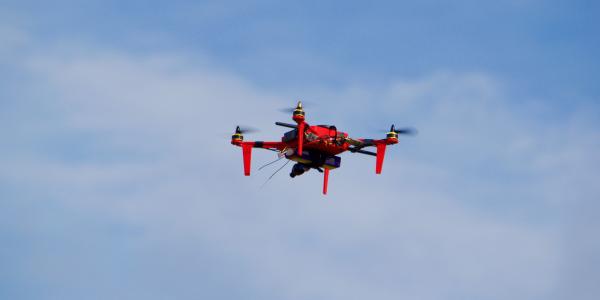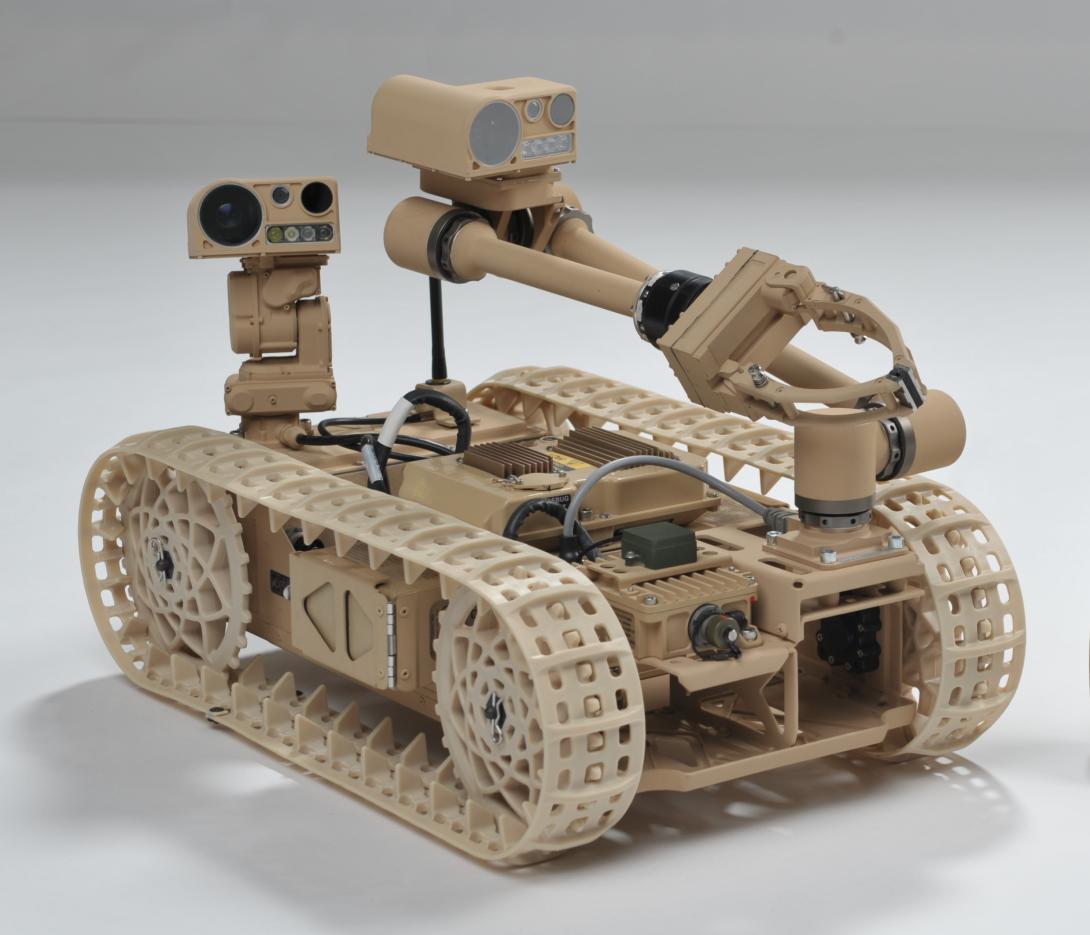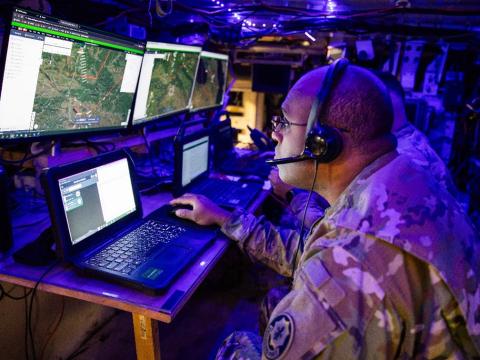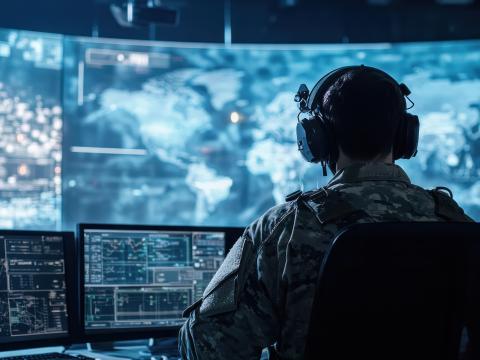Army Robots Prepare to Go to School
Robots that will equip the future U.S. Army will progress through an academic type of development that ultimately will have them graduate with full autonomy as equal partners with soldiers on the battlefield, if the Army Research Laboratory has its way. This learning regimen will allow them to grow into their roles as they mature from teleoperated machines to guided apprentices on their way to fully skilled battlefield operators that are teammates with warfighters.
The laboratory also will go to school as its robotics research bears fruit. It will explore just what types of robots can be delivered to the Army, and the outcomes of this expertise will shape Army concepts for both hardware and operations, says a laboratory official. This robotics research may spawn the development of a robotic proving ground that validates designs and capabilities in Army operations.
Jaret C. Riddick, director of the Vehicle Technology Directorate at the Army Research Laboratory (ARL), emphasizes that the lab neither produces a product nor competes with commercial manufacturers. Instead, it is working on technologies to enable advances for future soldiers and, where possible, demonstrate those technologies in relevant environments to help the warfighter imagine what the future battlefield actually will look like.
“There is an acknowledgment within the leadership in the Army that we are at a potential technology overmatch tipping point,” Riddick declares. “A further acknowledgment is that the battlefield of the future will see more and more autonomous systems employed.”
Current Army robots are teleoperated, meaning a human uses remote control to manage a robot. ARL research is focusing on fully autonomous vehicles that operate in concert with soldiers on the battlefield.
“We are going from [robots as] tools to teammates,” Riddick states.
The laboratory’s robotics efforts aim at enabling fully autonomous maneuver through complex environments. But Riddick emphasizes that this is about more than mobility. “It’s looking at how we move heterogeneous teams in space and time,” he says, adding that the heterogeneity refers to manned and unmanned systems. This type of robot would be highly or completely autonomous and able to work at operations tempo in either robot or mixed robot-human teams.
Achieving these goals will require significant advances in sensing, algorithms for perception and intelligence, and assured position, navigation and timing. It also will require resilient networks as well as manipulation and mobility concepts for future autonomous platforms, including ground and air systems. This autonomy would be achieved in steps over time, with robots gaining increasing amounts of independence as technology advances.
Riddick explains that near-term robotic applications are geared toward larger ground systems. For example, the Army’s next-generation combat vehicle cross-functional team (NGCV CFT) is pursuing a robotic unmanned vehicle as one goal. Plans currently call for two manned and four unmanned prototype vehicles to be delivered by the end of fiscal year 2019.
For Army aviation, the next-generation unmanned aerial system (UAS) will be able to operate in manned-unmanned teaming with future rotorcraft, Riddick continues. These tactical UASs also will gain increasing degrees of autonomy over time so they can operate in anti-access/area-denial environments without communication networks.
In all these endeavors, the ARL will affect robots’ autonomous capabilities through its work in artificial intelligence (AI) and machine learning, Riddick states. These capabilities, which are maturing within the ARL and the overall Army science and technology community, are foundational to what the robotic systems are being designed to accomplish.
The ARL already is spiraling technology into existing systems, he notes. Some of the work being done with the soldier-borne sensor, a small handheld flying autonomous system for tactical surveillance and reconnaissance, will include ARL robotics technology. Other ARL capabilities, such as self-righting skills for explosive disposal robots, have been deployed in the field.
The ARL’s Robotics Collaborative Technology Alliance, which includes academia and industry, will have a capstone demonstration next year that features technologies developed over decades of research, Riddick says. Its areas of interest include sensors; machine vision and learning algorithms; intelligence technologies to enable informed decisions; and resilient networks.
This demonstration also will address advanced mobility concepts that go beyond wheeled and tracked vehicles. Legged robots might be better teammates for soldiers in close tactical situations amid complex environments, he points out.
Riddick offers that these types of robots might begin to appear in three to five years as part of the NGCV effort. The ARL will spin out technologies early on to support the warfighter, and concurrently it will aim to push the understanding and imagination of Army leaders so they can envision the robotic battlespace in the 2035-2050 time frame. Further out, robots will feature greater collaborative learning and teaming abilities from ARL autonomy work.
“If we develop technologies and put them in research and demonstration environments, it helps us to see the options that the warfighter can then place into experiments to help them understand what that battlefield of the future really looks like,” he says. “It’s based on real research and real discovery that comes out of the laboratory and the Army [science and technology] community.”
In addition to increasing autonomy, ARL researchers are working on lighter robots that are energy-efficient, Riddick allows. A robot-intensive battlefield will face challenges with power requirements, and supplying energy to these hordes of robots will mandate “disruptive breakthroughs” at the tactical level, he says.
Robotic energy independence will be important to ensure independence for soldiers. The laboratory is looking at more energy-efficient power options that are multifuel-capable—even able to scavenge energy from the environment—to support long-running robots. Some robotic platforms might be able to help other Army systems by offloading power during operations, Riddick suggests.
The ARL’s robotics research is not without challenges. Riddick allows that the laboratory must maintain its focus on the most important objectives for the future warfighter. Accordingly, it must understand “the ecosystem” of robotics research so it can draw upon the best talent and research outcomes to allocate resources effectively.
Many technical hurdles remain. One is platform integration, especially with intelligence applications. Riddick notes that AI currently depends on large datasets and access to information repositories, but battlefield operations will not have that luxury. Small datasets will be sparse, and their data may not always be dependable. Connectivity also could be lacking. “The challenges around intelligence in a complex military environment are extreme,” he states. “And those challenges are not ones that we can necessarily depend on commercial industry to address without a real push from the military side to get after those problems. And that push comes out of what we do in basic research.”
Private industry and academia are part of the robotic ecosystem that Riddick cites. Many individuals from these sectors have participated in laboratory collaborative technology alliances, which helps strengthen bonds among participants. An ARL initiative called Open Campus would allow members of industry and academia to enter the laboratory. This concept is being pursued at regional ARL sites nationwide.
While its intent is to approach robotics holistically, the ARL is working on individual enabling technologies rather than building a product. Part of this goal is to focus on use-inspired research, Riddick says. The target is research outcomes from the basic robotics research that would be useful for the soldier, he adds.
The Army’s battlefield strategy is for robots to increase situational awareness, lighten soldiers’ loads, and facilitate movement and maneuver, Riddick points out. In some cases, the robot may actually take the lead on the battlefield, serving as the tip of the spear in tactical operations, he suggests. It might perform the dull, dirty and dangerous tasks that otherwise would fall to the soldier teammate. This robot also would sense the human’s condition and needs and adjust its behavior based on them.
Other potential applications are more general but involve innovative uses. Long-range precision fires, air missile defense, and network command, control, communications and intelligence all might benefit from robotic advances, and their innovations could influence Army doctrine significantly. “The degree to which we can align the knowledge products that we produce within the corporate research laboratory of the Army to have options for our senior leaders … may very well shape what emerges from these programs as they mature,” Riddick says.
The Army modernization plan is expected to be completed by 2028. The ARL’s robotics research is geared toward generating results by then, but it also will provide the seed corn for greater advances beyond that period. For the 2035-2050 time frame, robots should be capable of meeting whatever threats are emerging, Riddick allows.
“When you think about the possibility of having a robotic teammate that can go in and take care of some of those dull, dirty and dangerous tasks and free the soldier to have more space cognitively and functionally to deal with higher-level tasks, it’s really for the warfighter to figure out what type of option does that present,” Riddick declares.
This is all the more relevant in multidomain operations, in which the soldier is the most highly developed sensor among people and machines, he continues. This soldier would be free to perform the necessary high-level decision making in that multidomain environment—which would be revolutionary. “The pace of decision making across domains would bring us into a way of fighting that is safer for the soldier, more lethal and ensures the soldier can go out, fight, win and come home safely,” Riddick says.






Comments